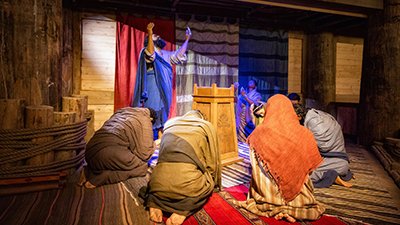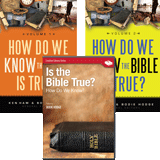Does an Eagle Carry Its Young on Its Wings?
Deuteronomy 32:9-141 is an inspiring passage which speaks of God’s care for Israel. Written by Moses at the end of the wilderness wandering, just before the Israelites would cross the Jordan river into the land of Israel, it speaks of God’s past care for the Israelites. In the middle of this passage (verse 11), Moses speaks of an eagle’s care for its fledglings as an obvious analogy of God’s care for Israel during this time.
This verse has become a popular topic for sermons and a much-copied inspirational social media post. But has the verse been misunderstood, misapplied, or misused? There have even been charges that this verse is not accurate and thus is a “Bible error.”
Lost in Translation?
Before we delve into these charges, it is important to look at the different English translations of Deuteronomy 32:11, as well as some of the Hebrew words which may help shed light on these questions.
NKJV: As an eagle stirs up its nest, Hovers over its young, Spreading out its wings, taking them up, Carrying them on its wings.
ESV: Like an eagle that stirs up its nest, that flutters over its young, spreading out its wings, catching them, bearing them on its pinions,
NAS: Like an eagle that stirs up its nest, That hovers over its young, He spread His wings and caught them, He carried them on His pinions.
HCSB: He watches over His nest like an eagle and hovers over His young; He spreads His wings, catches him, and lifts him up on His pinions.
NET: Like an eagle that stirs up its nest, that hovers over its young, so the Lord spread out his wings and took him, he lifted him up on his pinions.
So which translation(s) best captures the meaning of the text?
As can be seen, some versions translate the entire verse as actions carried out by the eagle for its young. Others translate the first half of the verse this way, and then translate the second half of the verse as God’s care for his people. And the HCSB, using the analogy of an eagle, translates the entire verse as God’s care for Israel. So which translation(s) best captures the meaning of the text? Or does the translation of this single verse work well in all three above translations in the larger context of the extended passage? We’ll explore that second question later.
A Bird by Any Other Name
The Hebrew word in this passage is נֶשֶׁר “nesher,” and although this word is usually translated as “eagle” in most English translations, there are a few examples where it is not and some where it could have been translated differently based on context. The word basically denotes a diurnal (active during the day) bird of prey, or even more generically a diurnal carnivorous bird. So is the passage even talking about an eagle?
Compare, for example, these renditions of Proverbs 30:17, where nesher is translated as “eagle” or “vulture”:
NKJV: The eye that mocks his father, and scorns obedience to his mother, The ravens of the valley will pick it out, And the young eagles will eat it.
ESV: The eye that mocks a father and scorns to obey a mother will be picked out by the ravens of the valley and eaten by the vultures.
HCSB: As for the eye that ridicules a father and despises obedience to a mother, may ravens of the valley pluck it out and young vultures eat it.
Bald Assertion
Also, when many think of an eagle, those particularly in North America often think of the bald eagle, so named not because it is lacking feathers on its head but because the feathers there are white. But American bald eagles are not native to the Middle East (there are 4 common species and 3 rare species of eagle found in Israel).2 The only “bald” birds (either having no feathers on their head, or only having short downy feathers on their heads) are vultures, four of which are common in Israel (Egyptian Vulture, Black Vulture, Griffon-vulture, and the Lappet-faced vulture.3 There are no truly “bald” eagles, but there are plenty of bald (or mostly bald) vultures. So the passage in Micah (below) would make more sense if nesher would have been translated as “vulture.”
Make yourself bald and cut off your hair, because of your precious children; enlarge your baldness like an eagle, for they shall go from you into captivity (Micah 1:16).
It is possible that a molting eagle could lose all the feathers on its head for a very short time, even though this is uncommon. Molting birds tend to lose (and then replace) feathers in patches, and some commentators have mentioned that this could be the thought of “enlarge your baldness” (i.e., “make your bald patches larger”) in the Micah passage. And though we think of eagles as hunting birds primarily, most will not turn up their nose at carrion, making the Proverbs 30:17 verse applicable to either an eagle or vulture. So, although the Hebrew word nesher may not definitively refer to an eagle in all places, it is safe to say that an eagle is a possibility and is the more probable rendering when the passages mention soaring ability (Proverbs 23:5, 30:19; Jeremiah 48:40, 49:16) or swiftness (Deuteronomy 28:49; Job 9:26; Habakkuk 1:8).
Bird Behavior
Another difference among the English translations is whether the eagle is “stirring up” or “protecting” its nest.
Another difference among the English translations is whether the eagle is “stirring up” or “protecting” its nest. The Hebrew verb הֵעִיר (hēʿīr) is most often translated as rouse, awaken, stir up, or incite. But alternate meanings can include protect, watch over, or nurture. Hebrew scholars are divided on which interpretation is meant in Deuteronomy 32:11.4 Some favor the “stir up” translation, asserting that the eagle rouses the nestling to encourage it to leave the nest and learn to fly. Others favor the “protecting” or “watching over” translation; since the verse speaks of caring for the nestling in the beginning, it is reemphasized here. In context, the entire extended passage of Deuteronomy 32:9–14 is about God’s care for Israel during the wilderness wanderings, so the “protecting” translation is easily validated. But those who favor the “stir up” rendering point out that verses 12–13 state that God guided or led Israel and “made him ride in the high places.” This last phrase quite possibly alludes to forcing a nestling to leave the nest and take its first flight. So again, both renderings have plausible arguments for their position.5
Charges of Biblical Error Refuted
The part of the verse most often criticized and labelled as error is the last half of the verse: “Spreading out its wings, taking them up, Carrying them on its wings.” But is this an error? Have there been no recorded cases of any eagles carrying or catching a fledgling on its wings? Actually, there have been several anecdotal cases, and two (at least) which have been recorded in bulletins and books:
“Last summer while my father and I were extracting honey at the apiary about a mile southeast of Tliacher School, Ojai, California, we noticed a golden eagle teaching its young one to fly. It was about ten o'clock. The mother started from the nest in the crags, and roughly handling the young one, she allowed him to drop, I should say, about ninety feet, then she would swoop down under him, wings spread, and he would alight on her back. She would soar to the top of the range with him and repeat the process. One time she waited perhaps fifteen minutes between flights. I should say the farthest she let him fall was 150 feet. My father and I watched this, spellbound, for over an hour. I do not know whether the young one gained confidence by this method or not. A few days later father and I rode to the Cliff and out on Overhanging Rock. The eagle's nest was empty.” (Quote attributed to a Miss F. E. Shuman.)6
V.C. Holmgren wrote,
Many ornithologists have thought that the Bible picture of an eagle carrying her young was merely figurative, but in recent years certain reliable observers have actually seen a parent bird let its young rest for a moment on the feathered back—especially when there was no other roosting place in sight. When an eagle nests on the ledge of a sheer-walled canyon, many feet above the earth, with no jutting tree or protruding rock to break the fall, the quick movement of a mother bird to offer her own back to a frightened fledgling may be the only way to let it live to try its wings again.7
Most ornithologists have stated that they have never witnessed this, and there are no journal articles which report this behavior among any eagle species. Note that most long-term fieldwork on eagle nesting and fledgling behavior has been carried out in North and South America and Europe, with little study on eagles native to the Middle East. Therefore, this could be a behavior among one (or more) of the birds native to the Middle East, though whether this protective act is even physically possible has been called into question. Regardless, does this argument invite the charge that the Bible is in error here? No, certainly not, as the verse is clearly a simile (“as an eagle” or “like an eagle”) comparing an eagle’s care of its young to God’s care for Israel.
In fact, in the extended passage of Deuteronomy 32:9–14, the main subject of the text is God. Verses 9–10 and 12–14 all speak of God’s care and affection for Israel. And as mentioned previously, many translators view the second half of verse 11 as specifically referring to God and not the eagle. One of the strongest factors supporting this interpretation is that there is a change of object in the Hebrew in verse 11, going from plural to singular, something frequently missed in many English translations:
While in verse 11a the object is plural (the young), in verse 11b it is singular, now matching the gender and number of the only other object in the immediate context, namely Israel. In light of this we can conclude that it is only verse 11a where the eagle is the subject, while in verse 11b it is God himself. As the eagle cares for his young (v. 11a), so too does God care for his people (v. 11b).8
Misusing the Text?
There are other Bible verses that speak of God carrying Israel on his wings (Exodus 19:4) or of God renewing their strength (Psalm 103:5; Isaiah 40:31) using the analogy of an eagle. So the clear zoomorphic (comparing God’s characteristics to the characteristics of an animal) simile in Deuteronomy 32:11 is not an isolated occurrence. But to insist and promote to others that this verse clearly teaches that eagles carry their young on their wings is misunderstanding the context of the larger text in question (Deuteronomy 32:9–14) and may be a misuse of what is actually being conveyed here. Furthermore, to do so requires ignoring the similes employed in verses 10 (anthropomorphic) and 11 (zoomorphic) and the clear comparison of God leading Israel in verse 12, and the poetic imagery of God’s care for Israel conveyed in verse 13. Just as we would not presume that Deuteronomy 32:13 means God will make rocks literally give forth honey, we should hesitate before claiming that, from just two verses prior, eagles literally carry their young on their backs. Figures of speech, analogies, and poetic language are pervasive throughout this historical narrative.
Choice Words
When considering the translation of Deuteronomy 32:11, remember that the varying translations all have plausible arguments backing them up. Did God have to “stir up” Israel during the wilderness wanderings to get them ready to enter the Promised Land? Yes, on several occasions because of their rebellious nature (Numbers 16, 20:2–13, 21:4–9, 25:1–9). Did God protect them during this time? Yes, by providing them manna (Exodus 16:35), miraculously helping them in battle (Deuteronomy 20:1–4), and providentially keeping their clothes and sandals from wearing out (Deuteronomy 29:5). And since the extended passage is speaking of God’s care for Israel, the most natural reading of verse 11 would have to include that aspect and not be a stand-alone verse only referring to an eagle’s behavior.
Misapplication?
It is recounting events which occurred roughly 3,500 years ago and as such gives us a glimpse of God’s past care for his people.
It’s a misapplication for Christians to use this verse in a universal naturalistic sense and claim that the Bible teaches that “all eagles carry their young on their wings.” If we try to force this verse to be a “guaranteed promise” to all believers today, we are misapplying this verse. This passage speaks of past events, and while it is certainly within God’s power to “bear us on eagles wings” (Exodus 19:4), that is not the point of this verse in Deuteronomy. It is recounting events which occurred roughly 3,500 years ago and as such gives us a glimpse of God’s past care for his people. But we can certainly still learn from and be encouraged by past examples of God’s love for his people (Psalm 77:11; Lamentations 3:21–25; Hebrews 12:1), know that he loves us (1 John 4:9–10, 19), and look forward to all the good that God works together or does for his people every day (Romans 8:28; James 1:17). In fact, we are commanded to meditate on all the good things God has brought into our lives (Philippians 4:8).
But we can’t read Deuteronomy 32:11 in isolation, nor forget that past events recorded in Scripture can also serve as an admonition, rather than merely encouragement. In fact, the people of Israel being addressed in that chapter were just getting ready to enter the Promised Land and had just gone through a period of judgement. The next portion of Deuteronomy 32 (verses 15–25) recounts and admonishes against forgetting the Lord, as that generation’s parents had done. The Apostle Paul reminded the Corinthians 1,500 years later of this very thing (1 Corinthians 10:5–11): the older Exodus generation failed to enter the Promised Land because of unbelief and rebellion. After Paul summed up the passage about the post-exodus generation, he also issued an admonition to the Corinthian church: “Therefore let him who thinks he stands take heed lest he fall” (1 Corinthians 10:12). So before we post our opinion about a Bible verse on social media, we should guard against misapplying it and focus on “rightly dividing the word of truth” (2 Timothy 2:15).
Footnotes
- All Scripture is NKJV unless otherwise noted.
- Lior Kislev, “Birding Tours and Birdwatching in Israel,” accessed July 8, 2019, http://www.tatzpit.com/site/en/pages/inPage.asp?catID=9&subID=12.
- Ibid.
- David J. A. Clines, ed., “ʿwr,” The Dictionary of Classical Hebrew, (Sheffield, U.K., Sheffield Phoenix Press, 1993).
- Ludwig Koehler, Walter Baumgartner, eds., “uwr,” The Hebrew and Aramaic Lexicon of the Old Testament, (Boston: Brill Publishing, 2000).
- Arthur Cleveland Bent, "Life histories of North American birds of prey pt. 1: Order Falconiformes." Bulletin of the United States National Museum i–viii, 1-409, 102 pls, https://doi.org/10.5479/si.03629236.167.i.
- V.C. Holmgren, Bird Walk Through the Bible (New York: Dover Publications 1988), 98.
- Hans-Georg Wünch, “Like an eagle carries its young,” HTS Teologiese Studies/ Theological Studies 72, no. 3 (2016): a3249, http://dx.doi.org/10.4102/hts.v72i3.3249.
Recommended Resources

Answers in Genesis is an apologetics ministry, dedicated to helping Christians defend their faith and proclaim the good news of Jesus Christ.
- Customer Service 800.778.3390
- © 2024 Answers in Genesis






